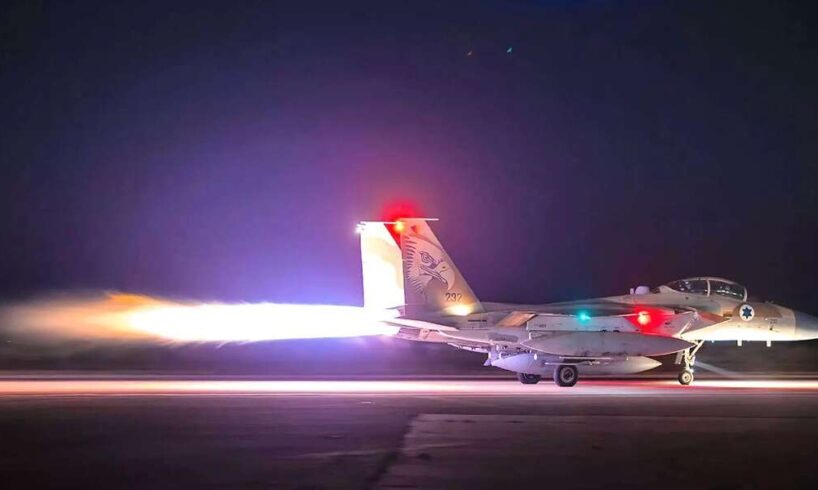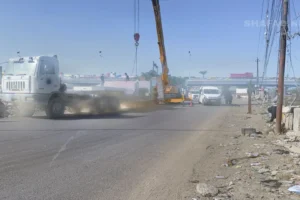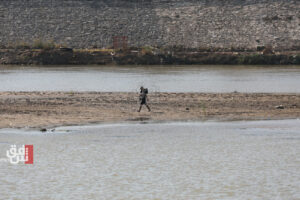
It’s likely the Iranian air traffic controller rubbed his eyes in disbelief. One night in March 2025, dozens of Israeli fighter jets appeared on radar screens, flying northeast from Israel. Armed with bombs, they traversed Syrian airspace toward Iraq and didn’t appear to be slowing down.
All they had to do was bank slightly eastward, and within less than an hour, they would be on Iran’s doorstep. But they didn’t. Instead, the aircraft continued to the northeastern tip of Syria, then turned around and flew back the way they came.
“That was the major rehearsal we did ahead of the Iran strike,” a senior Israeli Air Force official explained. “The aim was to rehearse the full operation at least once, flying a distance comparable to that of Iran. The easiest way to do that was to fly all the way across Syria, then turn back.”
Did the Iranians not spot you?
“And if they did? They knew we were preparing for a strike. It wasn’t a secret.”
Indeed, the operation in Iran was no secret. Yet three months later, on Friday, June 13, both Iran and the rest of the world were stunned when Israeli fighter jets launched a surprise assault: decapitating Iran’s military command, assassinating several nuclear scientists, hitting nuclear facilities, and achieving air superiority over Iran within 36 hours.
Israeli Air Force fighter jet. Photo: IDF Spokesperson’s Unit
The dazzling operation was publicly known as “Rising Lion” but within the Israeli Air Force, it was guided by a complex battle plan named “Iron Man.”
“It’s a deployment directive that aligns and guides the entire Israeli Air Force,” said a senior officer. “We positioned all the Air Force’s capabilities about 2,000 kilometers from Israel.”
Conversations with Israeli Air Force and defense officials reveal the intricate path of “Iron Man” to Tehran. This is how the Israeli Air Force prepared for the largest operation in its history.
The ambitious goal
Until recently, Israel’s plans for a strike on Iran had been relatively modest. “For the past 20 years, we were stuck in a ‘pinprick’ mentality,” said a senior defense official. “Sometimes it was a Mossad operation, sometimes an aerial strike. But it was always an operation, never a campaign.”
The paradigm shift came when Herzi Halevi assumed the role of IDF chief of staff. Early in his tenure, he presented a paper to Prime Minister Benjamin Netanyahu and then-Defense Minister Yoav Gallant proposing a shift in strategy, from a one-off operation to a full-scale military campaign. Halevi set the ambitious goal of achieving air superiority over Iran, to give Israeli jets free rein in its skies and pave the way to Tehran.
“When a squadron of F-15s is circling over Tehran, everything changes – physically and psychologically,” a defense source said.
Former IDF Chief of Staff Halevi, who brought a major shift in strategic thinking. Photo: IDF Spokesperson’s Unit
In his first meeting with Air Force Commander Maj. Gen. Tomer Bar, Halevi instructed him to begin preparations. But Bar was also dealing with internal opposition to the government’s judicial reform, which had led some reservists to suspend their volunteer service, posing a potential threat to operational readiness. Israel itself was not yet prepared for war with Iran. “The biggest concern,” said a defense official, “was the response from Hezbollah.”
Ten months later, that concern became reality. The October 7 attacks froze the Air Force’s ability to prepare properly for an Iranian campaign. Constant strikes in Gaza and Lebanon required dozens of jets to remain on high alert at all times, ready for Hezbollah’s elite Radwan force to cross the northern border. “At the same time, we had to maintain a certain level of munitions,” a senior insider noted.
Still, Bar realized early on in the war that the Iran file had been reactivated. “The understanding within the Air Force that Iran would ultimately have to be confronted came just days after October 7,” said a military planner. “The realization that this was a centralized, Iran-led axis left no other option.”
Serious internal discussions about a campaign in Iran began in March 2024. Just days later, the Air Force had a chance to prove its readiness. On April 1, Israel assassinated Hassan Mahdavi, the commander of the Syria-Lebanon Corps of Iran’s Islamic Revolutionary Guard Corps (IRGC), in a strike near the Iranian consulate in Damascus. The original plan had been to kill Mahdavi with a single missile targeting the room he was in – minimizing collateral damage and giving Iran space to avoid a major response. But intelligence failed to pinpoint his exact location, and the Air Force was ordered to level the entire building.
Even so, Israel hoped the strike – aimed at a building near the consulate, not the consulate itself – would keep Iran from entering the war. But Supreme Leader Ayatollah Ali Khamenei viewed it as a serious breach of Iranian sovereignty and immediately ordered retaliation.
That retaliation came on April 13 in the form of Iran’s “Night of Missiles” – hundreds of rockets, drones, and cruise missiles fired at Israel. Most were intercepted by Israel’s air defense system, with help from a coalition of allied fighter jets led by the IDF and US Central Command (CENTCOM) under Gen. Erik Kurilla. It marked the first time Iran had attacked Israel directly.
Intercepts over Israeli skies. Photo: AFP
Some Israeli cabinet members pushed for a fierce response. But the military resisted, concerned that escalating into full-scale war with Iran – while Hezbollah remained intact and the Air Force lacked full readiness – would play into Iran’s hands.
Diplomatic constraints
The IDF’s measured approach prevailed. The Air Force was instructed to respond by targeting just one S-300 air defense battery, one of five advanced Russian-made systems operated by Iran. A preparatory meeting with Netanyahu, Gallant, and Halevi revealed that diplomatic constraints made the original flight path into Iran unworkable.
As Halevi left Netanyahu’s office, he rushed to Bar’s headquarters. Bar’s team was preparing the strike, and Halevi told him they’d have to find a new flight route. Overnight, planners reconfigured the path, taking into account new refueling stops and necessary strikes on air defenses along the way. “It wasn’t just the flight path,” one insider marveled. “It was fuel logistics, anti-aircraft threats, everything. And they did it in hours.”
The April strike succeeded in destroying the targeted S-300 system. But not everyone was satisfied. National Security Minister Itamar Ben Gvir tweeted, “Lame!” Still, the limited strike was calculated and aimed at setting the stage for future operations. Crucially, it kept Iran from re-engaging militarily. Even the high-profile assassination of Ismail Haniyeh in central Tehran in late July 2024 didn’t alter Iran’s strategic restraint.
The months of relative quiet allowed the Air Force to lead a September 2024 campaign aimed at defeating Hezbollah. But as ground operations in Lebanon intensified and Hezbollah faced collapse, Iran decided to strike again.
The “second missile night,” in October 2024, reignited hawkish sentiment in Israel’s security cabinet. Proposals ranged from targeted assassinations to the destruction of Iran’s energy sector. “A full symposium,” said one source involved in the talks. But again, the IDF advocated a restrained response, and again, its view prevailed.
A missile launched at Israel from Iran. Photo: AFP AFP
On October 26, Israel launched “Operation Days of Atonement,” destroying Iran’s remaining four S-300 batteries and striking its solid-fuel ballistic missile industry. To signal its ability to target Iran’s energy infrastructure, Israel also hit a tactical air defense battery just 250 meters from an Iranian energy plant near the Iraqi border. “We denied them strategic air defenses and demonstrated we could hit tactical systems too,” a defense official explained.
A month later, when the Assad regime lost control of Syria, Iran became dramatically more exposed. With the regime’s collapse, the Israeli Air Force conducted a sortie that wiped out most of the Syrian air defense systems, allowing Israeli jets to avoid detours and instead fly eastward at high altitude, unimpeded across Syrian skies, saving significant amounts of fuel.
This removal of the Syrian threat also gave Israeli refueling planes freedom of movement near Iran’s border. “Effectively, we could now refuel fighter jets much closer to Iran, just before they entered for a strike,” an Air Force source said. “That gave them far more operational freedom.”
The Israeli Air Force could now, in essence, set up a fueling station on Iran’s doorstep and launch continuous, sustained airstrikes. “Only after Syria fell and the skies opened did the approach shift from ‘plan a major operation’ to ‘prepare for war with Iran,'” said a military source. “There was a realization that we had a rare opportunity to deploy many more aircraft and weapon systems.”
Before deploying dozens of jets over Iran, the issue of munitions had to be addressed. The April and October 2024 strikes had all been conducted from a distance, with Israeli planes never entering Iranian airspace. These were known as “standoff strikes,” made possible by precision-guided munitions, whose development and procurement had required massive budgets.
For years, Israel had funneled billions into a fantastical Mossad-led plan to destroy Iran’s nuclear program covertly, a plan insiders have described as “completely unrealistic.” Those funds came at the expense of other capabilities.
“These capabilities have been on the table for 12 years,” said a former defense official. “But for years, the system dumped absurd sums into that fantasy Mossad plan. And there just isn’t money for everything.”
Only during Naftali Bennett’s premiership, and later through a series of expert committees established by Netanyahu, was the Mossad option abandoned in favor of funding military capabilities. The shift was rooted in the recognition that a conventional military option was more feasible than the covert one.
The redirected budgets proved their worth. But to launch a sustained campaign to achieve air superiority and systematically destroy Iran’s ground-to-ground missile launchers, more was needed. That meant deploying the Air Force’s workhorses, older fighter jets equipped with large stocks of cheap, readily available bombs.
This was the foundation of Israel’s ability to operate across Iranian territory with manned aircraft, loiter over targets, drop heavy ordnance, and “bring the full weight of Israel’s might all the way to Tehran,” as one military source put it.
Which brings us back to the “Iron Man” battle plan.
Building a war machine
The assault on Iran was constructed atop decades of groundwork laid by the Israeli Air Force, transforming it into a strategic arm capable of operating far from Israel’s borders. In fall 2024, when Bar ordered his team to draft a plan for a sustained and massive strike in Iran, or in his words, “to turn the third circle into the first”, they knew they could lean on those foundations.
“This kind of campaign is based on structured battle procedures and building blocks laid down over decades, which built the Air Force into a strategic force, capable of operating in the third circle,” said a senior officer.
Still, those building blocks had to be assembled into a coherent whole. “You need to tailor general capabilities into specific operational components. We needed a plan that integrated all elements and turned theory into practice.”
Interestingly, many of the most innovative solutions came from the younger ranks and reached the desk of the Air Force commander. Many were accepted.
Managing the Air Force in the weeks leading up to the strike required the skills of a seasoned Sudoku solver. Photo: IDF Spokesperson’s Unit
To draft the battle plan, the Air Force created a “winning team,” as one insider described it. The operational headquarters was restructured to focus resources and manpower on the Iranian file. A dedicated Iran department was created, with sub-teams handling air superiority, refueling, and more. Meanwhile, squadrons began long-range training missions.
“Even once you have a plan, it doesn’t mean you can execute it,” said a senior officer. “We flew the distances and drilled components of the plan both in and out of Israeli airspace. It builds both readiness and a psychological sense of capability.”
This massive production for a sustained campaign in Iran mobilized every component of the Israeli Air Force, including its air defense systems, which would have to brace for Iranian retaliation. The Air Force also anticipated that its own bases would come under missile fire, meaning squadrons would have to keep operating under direct attack. Preparations were made accordingly.
Through the workshop
All this planning happened while the Air Force was still engaged on multiple fronts – Gaza, Lebanon, Syria, and Yemen – without letting up. The strike plan was designed to allow Israel to hit Iran while staying operational across all other arenas. Fighter jets involved in Iran’s aerial defense would launch missions with bombs already onboard. Once replaced mid-air by fresh aircraft, they would turn around to bomb Gaza targets before landing. “We couldn’t spare a single jet,” said a senior officer.
Because of the sheer strain on its fleet, much of the Air Force’s Iran preparations took place on the ground, through its maintenance and technical units. These teams made sure every jet was serviced, parts replaced, and performance maximized. “Think about it. You’re in a multi-front war, flying nonstop, over 600 days into combat, and now you have to launch a full-scale campaign against Iran,” a senior officer noted. “It’s an extraordinary effort by the technical crews to keep everything at peak performance amid a regional war.”
Some of the aircraft designated for the Iran strike were taken out of rotation and armed well in advance, meaning they couldn’t be used for other missions. Managing the Air Force in the weeks before the strike required puzzle-like coordination.
Early in the planning, the Air Force determined it would need to operate over Iran for 7 to 14 consecutive days to achieve maximum effect. At the heart of this was air superiority. Because while the initial “decapitation” strike on Iran’s general staff and nuclear scientists was impressive, true superiority was what would allow a long, large-scale campaign.
“A key goal of the plan was to hunt down missile launchers and reduce fire on Israel, while also targeting many other assets,” explained a source familiar with the operation. “That required heavy, low-cost bombs, not standoff munitions, which meant being able to bomb directly overhead. So, first we had to destroy dozens of air defense batteries and gain control of the skies.”
Once flying over Syria became routine and the strategic S-300 batteries were taken out, the next step was to eliminate Iran’s more basic air defense systems, those with a 100-kilometer (62-mile) range. And Iran had many.
Interceptor launch. Photo: IDF Spokesperson’s Unit
At the start of the war, the Iranians kept these systems hidden to avoid detection and destruction. Believing a major Israeli strike wasn’t imminent, they left the western border – facing Israel – largely unprotected. Most batteries were focused on Tehran and nuclear sites.
But as tensions grew, Iran moved more and more batteries west to counter a possible Israeli assault, thanks in part to increased domestic production. “They knew we were coming,” said an Israeli Air Force officer. “And they prepared.”
By June 2025, Iran had deployed about 15 batteries along its western frontier, seemingly securing it from airstrikes. Meanwhile, in the Air Force’s command bunker, planners worked on how to outsmart that very defense.
Cracking the Shield
Israel’s key advantage in this chess match was intelligence. A special unit in Military Intelligence was established solely to track and study Iran’s air defense batteries. For the first time, intelligence officers physically sat in the Air Force bunker, bringing real-time updates about battery locations.
“Just last week, we found ten more batteries we hadn’t known about,” said one official. “Eventually, we knew exactly where every single battery was. It took hundreds of people from Air Force Intelligence, Military Intelligence, and the Mossad.”
The plan to achieve air superiority didn’t involve destroying every system. On the first night of the attack, Israeli jets carved out two narrow corridors through Iran’s western air defenses, both in the north, providing easier access to Tehran. The southern border area near the Persian Gulf was left untouched.
When striking the batteries, the goal was to destroy their radar systems before a missile could be launched. It wasn’t just about avoiding being hit, it was because if a missile was fired, pilots had to jettison their bombs to evade it. “That means abandoning the mission,” said one Air Force source. “We couldn’t afford that.”
The resulting gaps, about 300 kilometers (186 miles) wide, allowed Israeli jets to penetrate deep into Iran. The next day, they pushed forward, destroying more batteries en route to Tehran. On the second night, they took out nearly all of the air defense systems in and around the capital. Where aircraft faced difficulties, Mossad teams on the ground stepped in and destroyed systems manually.
The elimination of these tactical batteries was a resounding success. During the operation, only a handful of missiles were fired at Israeli jets (some say none at all), and no manned aircraft were downed. In total, Israel destroyed 84 Iranian air defense batteries.
Early in the campaign, the Iranians tried to move systems around, hoping to hinder Israeli operations. But soon they began keeping them hidden, fearing more losses. “From day three, they barely engaged,” said one Israeli participant. “They knew that if a battery came out of hiding, we’d take it out. They shifted to full survival mode and barely fired.”
Israeli Air Force fighter jets en route to Iran. Photo: IDF Spokesperson’s Unit
The assault didn’t stop at launchers. Israel targeted Iran’s entire air defense infrastructure: command centers, military industries, personnel. The network collapsed quickly.
Iran’s fighter jets were largely irrelevant. Most stayed on the ground or flew to protect their own bases, avoiding any dogfights. Apart from a few limited strikes on those bases, Israel left the Iranian Air Force alone. The campaign focused entirely on eliminating air defenses.
By January 2025, “Iron Man” was ready. The target date for full operational readiness was set for April. Even after that, the Air Force’s planning team kept refining the strategy. Simultaneously, they closely monitored developments in Iran.
“We were facing an enemy that kept evolving and growing stronger,” said a senior officer. “We had to fine-tune the balance between reaching peak readiness and avoiding exposure of the plan.”
Secrecy was maintained even within the Air Force. Only a handful of senior officers knew when, or even if, the operation would launch. Hours before the strike, personnel began receiving orders to report to command centers, squadrons, and bases. These summons were issued until the very last moment to preserve the element of surprise.
Once the operation began, it exceeded expectations. Despite assumptions that some manned jets would be lost, and despite the pilots’ awareness that being downed in Iran meant near-impossible chances of rescue, not a single manned aircraft was hit during the entire 12-day campaign.
Footage of the strikes in Iran. Photo: Arab networks
“I’d rather crash into a mountain with my plane than eject and be captured,” one pilot said.
Achieving air superiority enabled the Israeli Air Force not only to strike freely but to actively “hunt” Iranian ballistic missile launchers, significantly reducing rocket fire on Israel, a key objective of the campaign. For 12 consecutive days, strike waves flew through Syrian skies, refueled safely nearby, and conducted multiple bombing runs over Iran. Eventually, drones joined the effort, roaming over Iran with near impunity.
“We used cheap, short-range weapons, which dramatically increased the number of targets we could hit,” said one official involved in the mission.
The plan had been built from the outset to allow continued full-force operations right up to the end. “The goal was to keep hitting with full intensity even as we neared potential closure,” said a senior officer. “We had Israeli Air Force jets flying over Tehran, maintaining pressure and consolidating gains until the very last moment.”
The operation culminated in a show of force: a massive US strike on Iran’s nuclear facilities at Fordo, Natanz, and Isfahan. In all these cases, it was the Israeli Air Force that cleared the path by eliminating Iranian air defense systems ahead of the American attack.
Even after a formal ceasefire, Iran violated the terms by launching two ballistic missiles at Israel. In response, Israel assembled a formation of 52 fighter jets to strike central Tehran, sending an unequivocal message. But when US President Donald Trump learned of the mission, he ordered the jets to turn back. “They were 20 minutes from launch,” said an Air Force source. “They were stopped at the very last second.”





